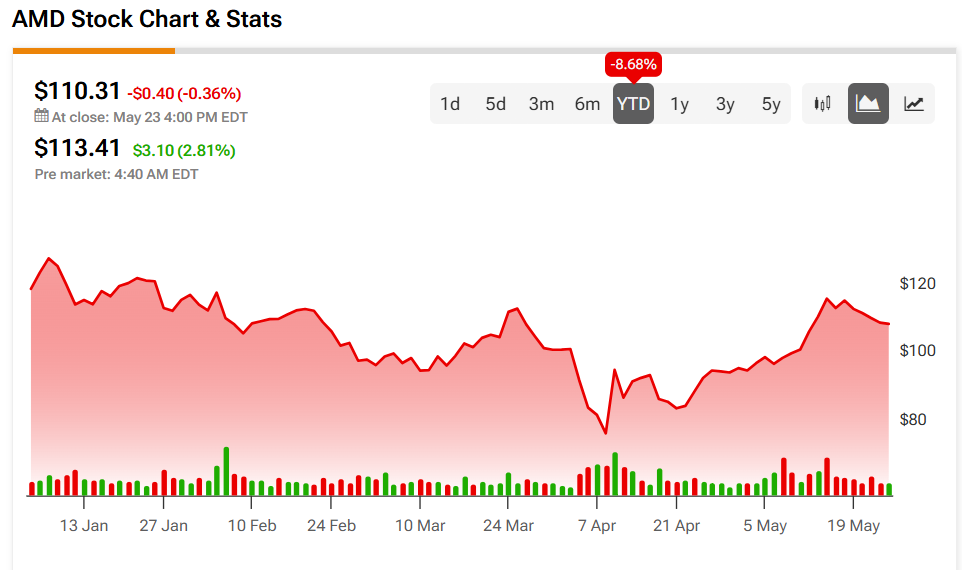Advanced Micro Devices (AMD) is no longer just chasing Nvidia (NVDA). Instead, it’s quietly building a full-stack AI ecosystem that could change the game. In that regard, TipRanks’ AI Analyst seems to like what it sees, giving AMD an “Outperform” rating and an 81 score, backed by strong growth signals in its data center and AI business.
Confident Investing Starts Here:
- Easily unpack a company's performance with TipRanks' new KPI Data for smart investment decisions
- Receive undervalued, market resilient stocks right to your inbox with TipRanks' Smart Value Newsletter

AMD and Red Hat Join Forces
The latest boost comes from a major new partnership with Red Hat, announced at the Red Hat Summit on May 20. AMD’s Instinct MI300X GPUs are now fully supported on Red Hat OpenShift AI, giving enterprise customers a powerful, open-source alternative to Nvidia’s AI dominance. OpenShift AI is a plug-and-play cloud platform built for AI and machine learning, giving data scientists the freedom to build, test, and deploy models fast, while still giving IT teams the control and security they need to sleep at night.
And this isn’t just surface-level integration. The two companies are working deep in the code, optimizing performance on AMD hardware for vLLM—an AI inference engine built for speed and scalability.
That means AI workloads can now run more efficiently on AMD chips, with fewer virtual machines, less energy usage, and lower overall cost. Even Microsoft Azure (MSFT) is getting in on it—Red Hat and AMD demonstrated large language model inference across multiple GPUs on a single Azure virtual machine, something that slashes infrastructure complexity and makes AMD a very real option for cloud-scale AI.
AMD Offers Full-Stack Experience
But this goes beyond GPUs. AMD’s EPYC CPUs are also tightly woven into the story. Red Hat OpenShift Virtualization now runs on EPYC processors, helping businesses modernize legacy applications while laying the groundwork for AI. It’s an end-to-end stack: virtual machines, containers, inference engines, and high-performance hardware.
AMD’s AI ecosystem now spans cloud providers, open-source platforms, and enterprise infrastructure, and the market is starting to respond. In Q1 2025, AMD reported $7.4 billion in revenue, up 36% year-over-year. Data center revenue soared 57%, and the AI business posted a strong double-digit increase. The company also announced a $6 billion share buyback, signaling confidence in its future performance.
Yes, there are risks. Export controls on China are expected to shave $1.5 billion off this year’s revenue. And some fund managers are backing away amid valuation concerns. But the big picture looks different: AMD is no longer just a chip supplier—it’s becoming an AI platform company.

What Spark Sees in AMD
That’s what TipRanks’ AI Analyst is picking up on. The model isn’t just reading earnings—it’s analyzing product launches, strategic partnerships, and macro trends. And it sees AMD executing well in the right places.
With an “Outperform” rating and a 14%+ upside based on a $126 price target, AMD’s AI ambitions are gaining credibility. Investors aren’t just betting on better chips anymore—they’re betting on an ecosystem. And that’s a bet AMD looks increasingly ready to deliver on.
Is AMD a Buy or Sell?
The Street’s analysts rate Advanced Micro Devices as a Moderate Buy, with an average AMD stock price target of $126.55. This implies a 14.72% upside.

Looking for a trading platform? Check out TipRanks' Best Online Brokers guide, and find the ideal broker for your trades.
Report an Issue















